Top 10 Busiest Ports In The World
[Updated for 2024] The busiest ports in the world are determined based on the container traffic passing through them. Thus, it is not necessary that the biggest ports in the world are also the busiest ports in the world.
The marine domain has increased dramatically in the past few decades, necessitating port and harbour facilities to accommodate these ever-increasing requirements.
This is precisely why shipping authorities in every nation are focussing on ensuring that their shipping ports are adequate to cater to the needs of the industry operators and drivers.
However, even while each nation focuses on improving its port infrastructure, there are a few global leaders with marine ports – bigger and busier than all others.
It is interesting to know that the busiest port facilities are in Asia, given the continent’s geographical position amidst crucial maritime trade routes connecting European and Middle Eastern ports.
Below are details about the 10 busiest ports in the world, each singular and unique.
1. Port of Shanghai, China
The Shanghai Port, owned by the Shanghai International Port Company Ltd, tops the List of the busiest ports in the world in 2024. Located in the People’s Republic of China, in Shanghai, this Port is also regarded as the world’s most rapidly growing economy.
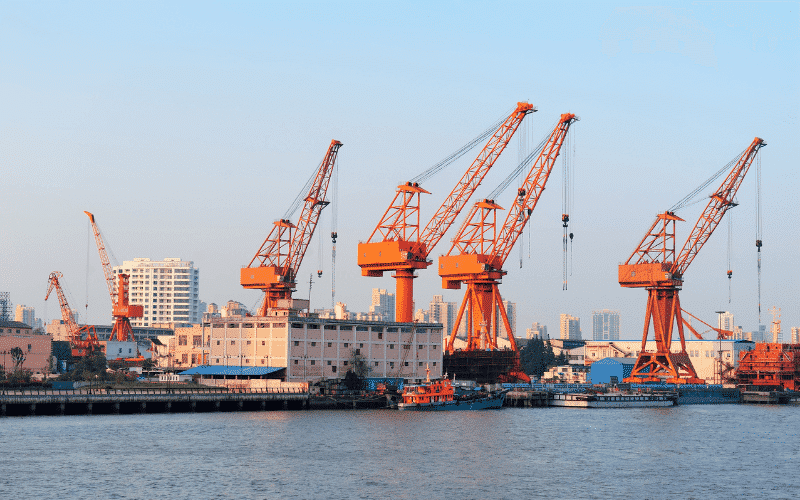
In 2019, it handled a whopping 37.1 Million TEUs of cargo volume. In 2020, the annual cargo traffic handled at the Port was around 43.5 million TEUs, making it the globe’s busiest container facility.
Shanghai Port handled 49 Million TEU in 2023 and will likely maintain its status as the world’s busiest container port for the 14th consecutive year.
The public Port forms a viable maritime porting channel for the River Yangtze and the East China Sea. Its construction and development have been acclaimed as crucial factors in the development of the city of Shanghai.
Spanning an area of 4 km2, the Port is a crucial centre of maritime international trade and commerce, laden with the latest infrastructural facilities and a giant network of freight and passenger links connecting it with important trade routes around the globe.
It mainly handles bulk shipments of coal, metal ores, petroleum and its derivatives, steel, machinery and construction equipment.
Comprising 125 wharves and 19 terminal facilities, the Port can accommodate the world’s biggest ships and carriers. Apart from the five major port areas, the Port also contains a cruise ship terminal with an annual handling capacity of more than 1 million people. More than one-fourth of China’s trade is handled at Shanghai port.
2. Port of Singapore
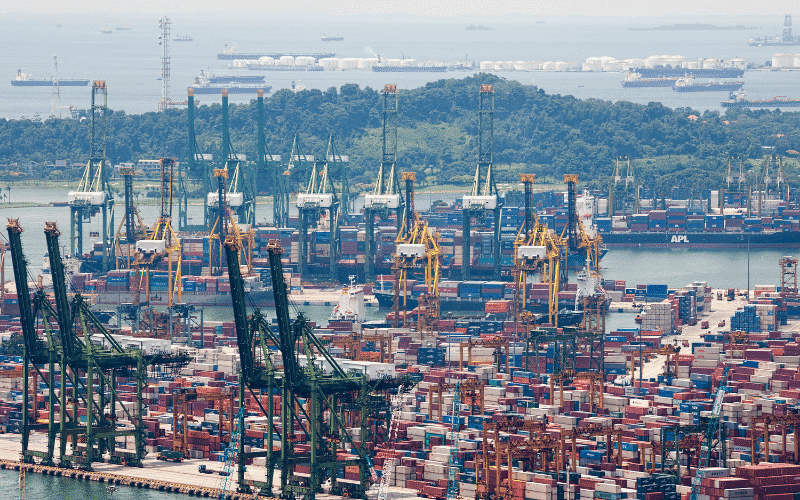
The Singapore port is a collective identification of all porting terminuses it encompasses. The Maritime and Port Authority of Singapore operates its multipurpose terminals at Keppel, Pasir Panjang, and Tuas.
Singapore has been instrumental in helping to reshape the Singaporean economic system. In 2020, the Port recorded an annual throughput of 37.5 million TEUs.
It handled 39 million TEUs in 2023, a 4.6% increase compared to 37.57 million TEUs in 2021.
Singapore Port is the world’s busiest container transhipment facility, offering maritime trade connectivity with 600 seaports in over 100 countries. It is also one of the largest bunkering facilities in the world. The port has 84 berths spread across six major port terminals and receives 130,000 vessel calls annually.
A fully mechanised terminal is also being constructed at Tuas, expected to be completed by 2040, with a handling capacity of 65 million TEUs.Upon completion, it would be the largest fully mechanised terminal facility in the world.
The Port’s terminals are equipped to handle diverse bulk, breakbulk, liquid and containerised cargo. They efficiently handle oil, petroleum products, natural gas, cement, automobiles, machinery, etc.
An important terminal in Jurong deals mainly with steel, cement, and copper slag. The Pasir Panjang Terminal can handle the biggest container ships with more than 12,000 TEUs.
The Port offers its national and international customers various services, including ship repairs and maintenance, cold storage facilities, container washing, and container tracking.
3. Port of Ningbo-Zhoushan, China
The Ningbo Port is situated on the coast of the East China Sea in the province of Ningbo and Zhoushan, Zhejiang, near Hangzhou Bay. In 2023, it became the third busiest Port in the world after handling more than 35 Million TEU.
The Port has shipping links with 600 ports across 150 countries.
It is operated by the listed company, Ningbo Zhoushan Co., Ltd, but is 76.31% owned by government-owned Ningbo And Zhoushan Port Group Co., Ltd.
The principal cargo handled at this Port includes bulk, breakbulk, crude oil, product oil, liquid chemicals, grains, coal and machinery.
The Port comprises 19 port regions and more than 300 functional berths capable of accommodating vessels weighing over 50,000 DWT. Its biggest terminals are the crude oil handling facility, an international container terminal and a specialised terminal for handling liquid chemicals. These facilities handle the world’s biggest ships and carriers, weighing over 200,000 tonnes.

The Port of Ningbo is known for providing quick and reliable customer service. Owing to its high-tech logistics system and world-class container handling facilities, the Port has offices for the world’s top shipping companies.
4. Port of Qingdao, China
Qingdao Port is located near the Yellow Sea in Shandong Province, China. It became operational in the late 18th century and is an important Asian hub of international trade in the West Pacific region. In 2023, it handled over 30 Million TEU, becoming one of the fastest-growing Chinese ports.
The Port comprises four major ports, namely the Qianwan, Dagang, Huangdao, and Dongjiakou port areas.
The Dagang port comprises 18 operational berths dedicated to conventional cargoes such as grains, steel products, and aluminium oxide.
The Qianwan port has 40 berths for handling containers, metals, coal, wood pulp, etc. Huangdao port is an oil terminal capable of accommodating huge oil tankers at 11 oil berths. It also handles crude oil, petroleum, and its products. The Dongjiakou port includes 17 berths for handling solid and bulk cargoes.
The Port offers world-class stevedoring facilities and can accommodate the biggest cargo carriers, iron ore vessels, and oil tankers. It has the latest port operating system and partially automated container terminals.
5. Shenzhen Port
Shenzhen comprises numerous ports spanning the Shenzhen shoreline, Guangdong, China. It is divided into two main eastern and western port areas and comprises five major terminals.
In 2023, Shenzhen Port handled 26.9 million TEU in 2023.
The government-owned Port has 140 docks, which handle diverse cargo and container vessels of varying sizes. Fifty-one wharves are dedicated to ships weighing over 20,000 DWT, and 19 facilities are dedicated to containers. The Port also has 18 passenger berths.
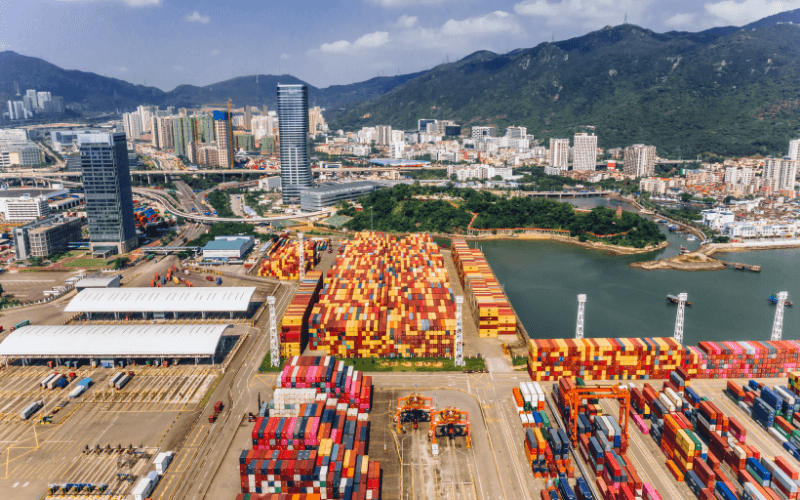
The Port of Shenzhen caters to industrial units and companies situated on the delta of the River Pearl.
The Port is regarded as the second most engaged shipping port in China, especially in the southern part of the Chinese mainland.
The Chiwan and Shekou container terminals are in the western port region, while Yantian Port, Shenzhen’s busiest container terminal, is in the eastern port area.
The Port is linked to 300 major ports in 100 nations. Around 40 major shipping companies are located at the Port, and over 120 container lines have started from it.
6. Port of Busan, South Korea
Owned by the government of South Korea, Busan Port is situated at the tip of the Korean peninsula. The Port is divided into two parts: international trade and commerce are carried out in the eastern port region, and fisheries are the major activity in the western port area.
Busan Port is South Korea’s largest Port, handling 22.75 million TEU in 2023.
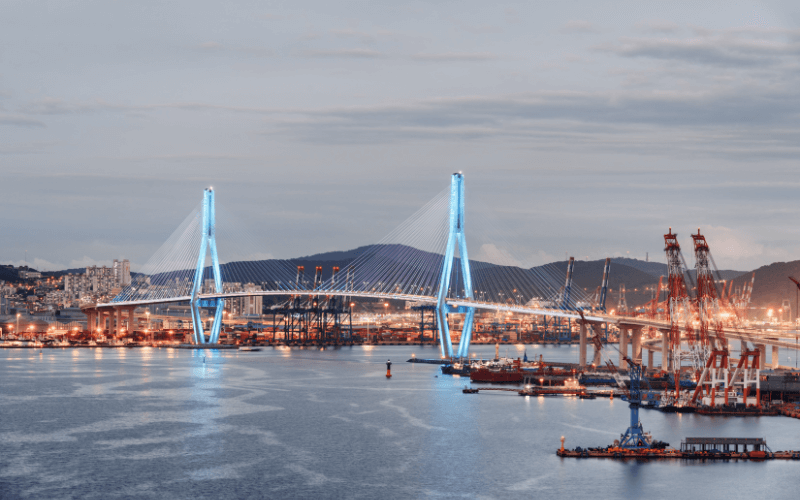
It is a crucial maritime gateway for the nation, linking it to the ports in the Pacific and major Asian ports. It handles containerised cargo, including fertilisers, meat, metal, leather, oils, iron ore, wood, natural sand, sugars, petroleum, and coal.
The Busan port comprises 4 port areas, a facility for handling passengers and 6 container handling facilities.
Over 30% of the country’s maritime cargo passes through the Busan port. It also handles around 90% of the nation’s containerised goods and over 50% of its fisheries sector production. More than 120 cargo ships visit the Port every 24 hours.
7. Port of Tianjin, China
Operated by Tianjin Port Group Ltd, the Tianjin Port is the major port facility and a crucial logistics and shipping centre of North China. Situated on the western coast of Bohai Bay, it also serves as Beijing’s maritime gateway.
It is the most extensive artificial port facility in China. In 2023, it handled 21.8 million TEU and had trade connections with over 600 ports across 190 nations.
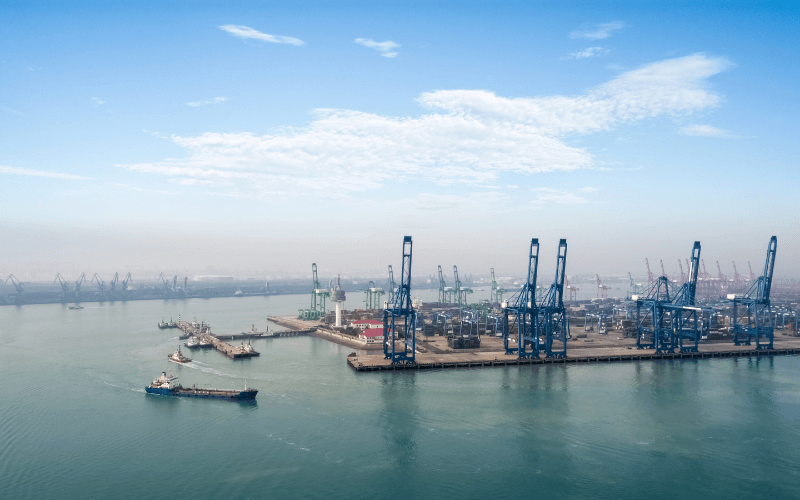
Tianjin port covers more than 120 km2, has a quay length of 34 km, and comprises more than 170 cargo ship berths. It has two passenger terminals and nine port areas, of which three, Beijiang, Nanjiang, and Dongjiang, handle most trade operations. It also has six major and two temporary anchorage areas.
It is also connected to 13 Chinese provinces and has direct linkages with the Northeast and Mid-Asian regions. Lying in the special economic zone, the Port handles all kinds of containerised and non-containerised cargo, such as metals, ores, oil, petroleum, vehicles, steel goods, grains, cereals, coal, etc.
8. Port of Guangzhou, China
Guangzhou Port is one of the most important Chinese ports, and it has maritime trade connections to more than 300 ports in over 100 countries.
It is located in Guangzhou, Guangdong and is owned by the Guangzhou Port Group Ltd. It handled 20.8 million TEU in 2023.
It has been operational since ancient times and is strategically located at the intersection of three important rivers. The Port is a crucial transportation hub for the region’s industries in Guanxi, Sichuan, Hubei, etc.
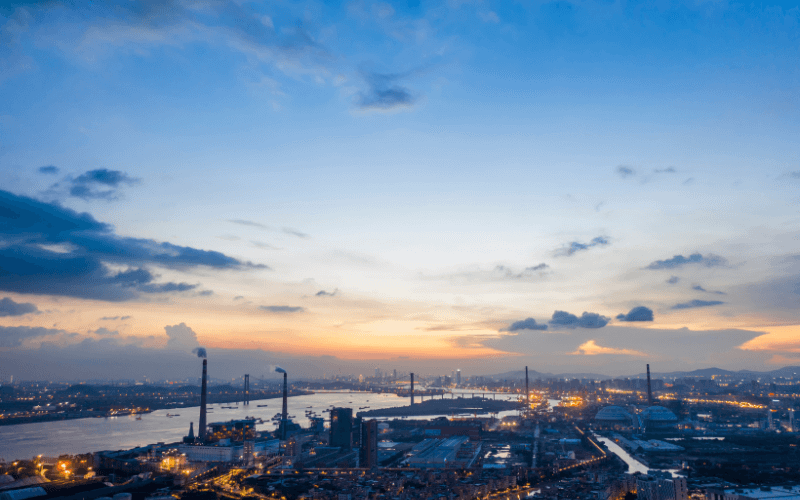
The Port has 49 wharves and handles an array of agricultural and industrial goods such as oil, coal, fertilisers, chemicals, cereals, grains, metal ores, automobiles, etc.
Nansha Port, part of the main Guangzhou port area, handles more than 75% of the total cargo traffic at the Port. It comprises over 20 berths and over 60 specialised cranes and can accommodate the biggest cargo carriers.
9. Port of Jebel Ali, Dubai
Also known as Mina Jebel Ali, this is a deep water port 35 km southwest of Dubai in the Persian Gulf. It was built in the 1970s to supplement the operations at Port Rashid.
It has the biggest artificial harbour in the world and 77 berths with aluminium, cement and gas facilities. It can also accommodate RORO, container cargo, dry bulk, break bulk, liquid cargo, LPG, LNG, etc.
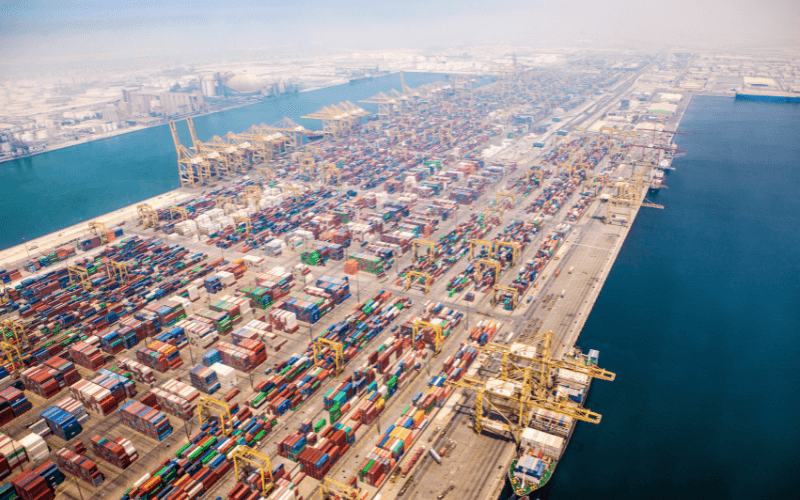
The Port is undergoing expansion to diversify and increase its handling capacity further. In 2023, Jebel Ali processed 14.47 million TEUs and secured its place as the 10th busiest Port in the world after knocking out the Port of Hong Kong from the List.
10. Port of Hong Kong
The Port of Hong Kong is located in the South China Sea off the coast of southern China. In 2023, the Port handled 14.345 million TEU.
It is a deepwater seaport known for being one of the ideal natural harbours in the world.
The harbour covers 4900 ha and is one of the busiest ports in the world. It handles container cargo, RORO, bulk, breakbulk, liquid cargo, multipurpose cargo, LPG, etc. It also has dry dock facilities.
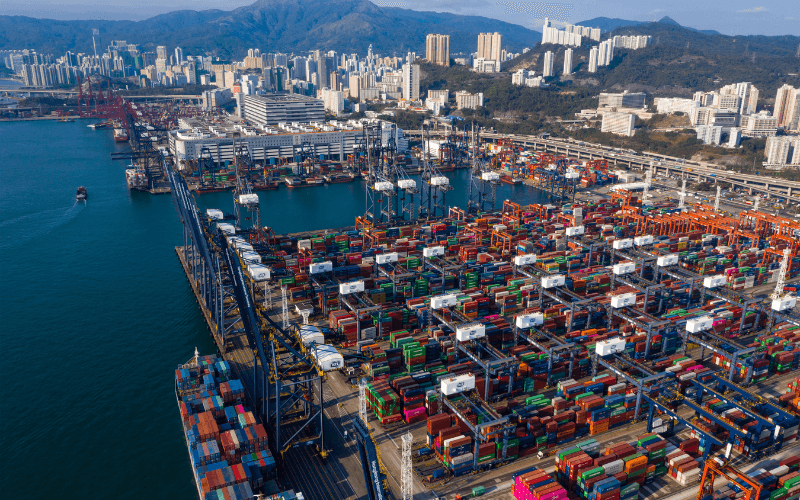
The Port lies at the centre of the Asia-Pacific and is strategically positioned on the Far East trade routes, which has been vital for the region’s development.
It has 8500 m of quays, nine terminals with 20 berths for massive ships, 7804 m of quays at cargo working areas, and 29 mooring buoys for oceangoing ships. It also has four passenger ferry terminals and a private cruise terminal.
11. Port of Los Angeles, California
Los Angeles Port, located in San Pedro Bay, is the principal trade gateway of North America. It has remained the top container port in the U.S. for 24 consecutive years.
In 2023, the Port generated 292 billion dollars in trade and handled 8.63 million TEU the same year.
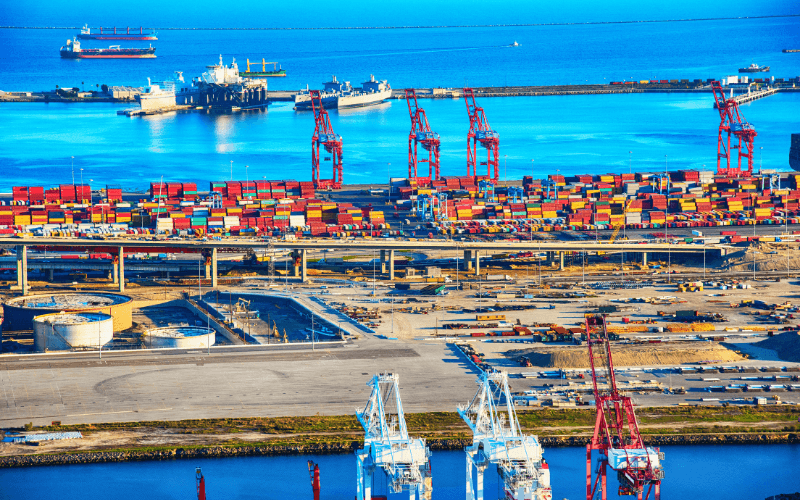
Los Angeles Port covers 3000 ha of land and water and has around 69 km of waterfront. It also boasts one of the biggest man-made harbours in the world and specialised facilities for different cargoes.
It has 25 cargo terminals, eight container terminals, 182 km of on-dock rail and over 80 cranes. Its top imports are apparel, footwear, electronics, furniture, and automobile parts, and its top exports are pet and animal feed, scrap metal, soybeans, wastepaper etc. Its major trade partners include China, Japan and Vietnam.
You might also like to read:
- 10 Major Ports In China
- 10 Major Ports In India
- 7 Major Ports of South Africa
- 10 Major Ports in Europe
- 7 Major Ports of the United States
Disclaimer: The authors’ views expressed in this article do not necessarily reflect the views of Marine Insight. Data and charts, if used, in the article have been sourced from available information and have not been authenticated by any statutory authority. The author and Marine Insight do not claim it to be accurate nor accept any responsibility for the same. The views constitute only the opinions and do not constitute any guidelines or recommendation on any course of action to be followed by the reader.
The article or images cannot be reproduced, copied, shared or used in any form without the permission of the author and Marine Insight.

About Author
Raunek Kantharia is a marine engineer turned maritime writer and entrepreneur. After a brief stint at the sea, he founded Marine Insight in 2010. Apart from managing Marine Insight, he also writes for a number of maritime magazines and websites.
Do you have info to share with us ? Suggest a correction
Subscribe To Our Newsletters
By subscribing, you agree to our Privacy Policy and may receive occasional deal communications; you can unsubscribe anytime.




